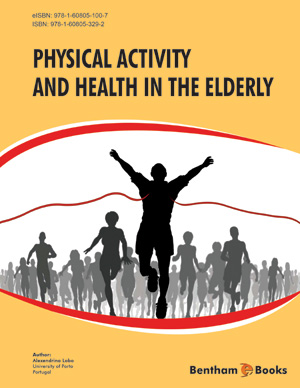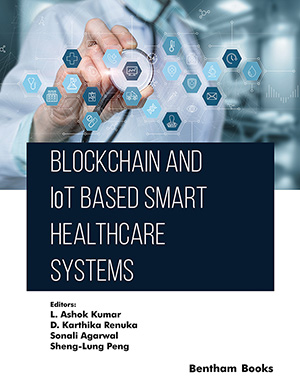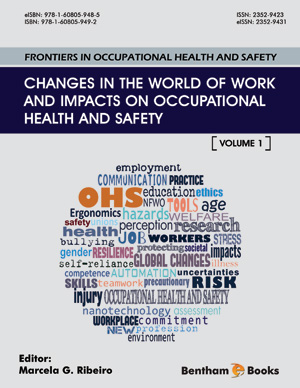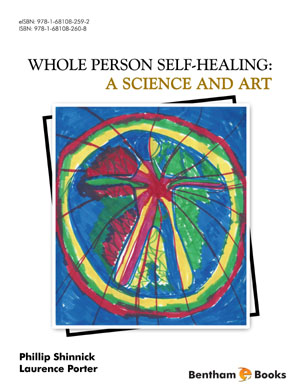Elderly
Page: 1-11 (11)
Author: Alexandrina Lobo
DOI: 10.2174/978160805100711001010001
PDF Price: $15
Abstract
Aging of the population has been one of the many successes of mankind; however, it is also one of the biggest growing challenges, in addition to its social, economic and political consequences, World Health Organization (WHO), 2005 [1]. Furthermore, the aging of the population increased since several decades in each country around the world. That’s why it becomes a public health care. From a public health stand-point, it is very important to identify and develop preventive strategies that may attenuate the gradual decline in functional ability associated with the aging process. The elderly, that were more physically active revealed a positive attitude towards life, were healthier and demonstrated a better capacity to face stress and tension [2]. Regular participation in physical activity, easily increased the functional status and maintained an adequate level of physical and cognitive functions [3].
Physical Activity
Page: 12-20 (9)
Author: Alexandrina Lobo
DOI: 10.2174/978160805100711001010012
PDF Price: $15
Abstract
After the industrial revolution, sports generally exclusively for the privileged social classes but with time had been gradually extended to the working classes. Many governments, NGO's (Non-Governmental Organizations), Institutions and companies have taken up themselves to promote sports through widespread public programs to raise public awareness of the practice of sport and regular exercise. The benefits of regular physical activity in elders are extensive and have positive effects on the quality of life. Special importance has been attached to the elderly and various considerations, such as limitations have been acted upon with respect to certain guidelines. In the organization and implementation of various physical activity programs, various suggestions have been mentioned for consideration.
Physical Activity Programs for Elders
Page: 21-30 (10)
Author: Alexandrina Lobo
DOI: 10.2174/978160805100711001010021
PDF Price: $15
Abstract
Basing our argument on the Current health-related physical activity (PA) guidelines, elders are encouraged to accumulate minimum 60 minutes per day of moderate or vigorous PA for a healthy life style [1]. American College of Sports Medicine (ACSM) [2] and Centers for Disease Control and Prevention (CDC) [3] recommend a target intensity of 50-85% of oxygen uptake reserve [4], that range includes at least 30 min per day of moderate-intensity activity, in bouts of at least 10 min each; or continuous activity for minimum 20 min 3 days per week [1]. Although, the United States Surgeon General recommends daily regular exercise, many elders do not adhere to this recommendation, thus do not exercise [5, 6]. These observations with regards to moderate PA, suggest that it is necessary that the elderly spend their leisure time more actively. Current recommendations have recognized that a combination of aerobic activity, strength training and flexibility exercises is important for maintaining physical function in elders [7, 8]
Physical Performance
Page: 31-36 (6)
Author: Alexandrina Lobo
DOI: 10.2174/978160805100711001010031
PDF Price: $15
Abstract
There is abundant evidence that aging makes elderly people weaker, slower, less powerful and also causes a deterioration in their balance and reaction time [1-3]. Nevertheless, it is still difficult to make a clear distinction between the effects of aging, deconditioning and disease with respect to decreased performance and health status. Since, most of the aging studies have cross-sectional designs and therefore, are prone to confounding, they cannot give a clear answer about true effects of aging. Previous investigations have demonstrated that some components of physical fitness in elders can be improved by physical activity (PA) [4-6].
Physical Activity and Life Expectance
Page: 37-41 (5)
Author: Alexandrina Lobo
DOI: 10.2174/978160805100711001010037
PDF Price: $15
Abstract
Taking a glimpse outside the life expectancy period of persons, if these effects are compared to middle aged persons, there exist reasons in relation to cardiovascular aspects necessitates to an increase in the number of interventions in relation to the elderly. Group, communitarian and educative programs are efficient to increase the physical activity (PA) of this group, usually with higher prevalence of a sedentary lifestyle and cardiovascular morbidity. The preventive benefits of the PA can be measured by the alteration of the weight, arterial pressure, diabetes or hypercholesterolemia, muscular performance and mental concentration. When controlling these risk factors, any independent contributors are not verified in the different PA patterns in cardiovascular diseases. In both genders involving a wider specter of ages, the epidemiologist’s comments suggested that moderate activities, such as the simple task of walking, independent of the direct or indirect effect, is enough for the reduction of cardiovascular disease, in the order of 21-24%.
Organization of Sport Animation
Page: 42-45 (4)
Author: Alexandrina Lobo
DOI: 10.2174/978160805100711001010042
PDF Price: $15
Abstract
The scientific evidence that exercise promotes long-term benefits is surprisingly scarce and it is therefore necessary to design longitudinal studies in elderly workers to determine whether exercise can prevent, slow or reverse the aging process, and thus to have a beneficial impact on the well-being of the elderly workers [1].
Falls in the Elderly
Page: 46-55 (10)
Author: Alexandrina Lobo
DOI: 10.2174/978160805100711001010046
PDF Price: $15
Abstract
Functional decline predisposes to the need for home services and hospitalization [1] and impaired mobility is an independent predictor of falls and fall-related injuries in older adults [2]. Regular physical activity is important to older adults, there is substantial evidence that physical activity reduces the risk of falls and injuries from falls [3], and prevents or mitigates functional limitations [4, 5].
Rehabilitation in the Elderly
Page: 56-62 (7)
Author: Alexandrina Lobo
DOI: 10.2174/978160805100711001010056
PDF Price: $15
Abstract
Exercise regimen tailored to individual´s specific conditions also offer opportunities for them to participate in altering the course of their disease, such as by maintaining muscle strength and mobility. An individualized treatment plan targets relief of pain, control of inflammation, maintenance of joint integrity and maximization of function [1], goals must be realistic and acceptable to the client.
Exercises with Dislocation
Page: 63-67 (5)
Author: Alexandrina Lobo
DOI: 10.2174/978160805100711001010063
PDF Price: $15
Abstract
Lengthening of all the muscles
i) Walk with stockings to cushion well the soles of the feet. In the case where one is carrying out physical activity outside one should always use comfortable trainers.
ii) To lengthen the calf muscles raise the feet and support the body weight on to the tip of the toes. Walk with the raised toes while maintaining a raised head. (figure)....
Exercises in Dorsal Position
Page: 68-70 (3)
Author: Alexandrina Lobo
DOI: 10.2174/978160805100711001010068
PDF Price: $15
Abstract
Aim: To reinforce the abdominal muscles. To extend the lumbar and dorsal muscles. Massage the back and spine. To improve the circulation from the skin
i) To put the knees on the abdomen: first, with each one of the legs; then, with the united two. To set the air free while bringing near them of the chest. To pull the air while the vertebrae and the legs touch the ground. (Fig. 20)
ii) The rail of the train: to put the legs near to the gluteal ones, with the feet well rested on the ground. To take the heel ahead and to leave which lapse as on a rail, until the leg stretches out to the utmost, while it dies. While inspiring, inflecting and raising the leg, like if it was being pulled by a thread. (Fig. 21)....
Exercises Seated in the Ground
Page: 71-71 (1)
Author: Alexandrina Lobo
DOI: 10.2174/978160805100711001010071
PDF Price: $15
Abstract
Aim: Gentle mobilization of the column
i) Sitting on the buttocks, supporting the hands in the ground behind the hips, semi inflected legs, take the knees of a side to other. (Fig. 30)
ii) Hands supported near the hips. Inflect the tips of the feet and be maintained in the same position; next, spread out and maintain. Inspire while inflecting and expire slowly while spreading out. (Fig. 31)....
Exercises in Four Supports
Page: 72-72 (1)
Author: Alexandrina Lobo
DOI: 10.2174/978160805100711001010072
PDF Price: $15
Abstract
Aim: To reinforce the musculature of the back, of the lumbar and dorsal muscles; to correct problems of column; to improve the posture
i) The cat: in 4 supports, to mobilize the hips in gently side to-and-fro. The back must remain straights, without be bending, and the pelvis, loose and relaxed. (Fig. 33)....
Exercises with Accessories
Page: 73-76 (4)
Author: Alexandrina Lobo
DOI: 10.2174/978160805100711001010073
PDF Price: $15
Abstract
Exercises with ball
i) Hold the ball with the palms of the hands. Raise the ball above the head and slowly lower it down towards the chest. (Fig. 36)
ii) Hold the ball chest-high with the elbows and alternately squeeze with both hands and release keeping a fixed position of the hands and elbows. (Fig. 37)....
Abbreviations
Page: 77-77 (1)
Author: Alexandrina Lobo
DOI: 10.2174/978160805100711001010077
PDF Price: $15
Glossary
Page: 78-78 (1)
Author: Alexandrina Lobo
DOI: 10.2174/978160805100711001010078
PDF Price: $15
Introduction
Physical inactivity is not only an individual's personal problem but is identified as a serious public health issue. Prolonged inactivity that occurs among many elderly persons tends to lead into a gradual decrease in all components of physical fitness, thus compromising their quality of life. Scientific research has shown that physical exercise can slow down both the psychological and physical aging clock. Engagement in health promoting behavior in the domains of physical activity, healthy dietary practice and stress management are considered useful strategies to enhance functional capacity among elderly people. These practices delay the onset of chronic diseases, minimize negative psychological effects and improve social networks and the quality of life, particularly for the elderly. This Ebook goes a long way in promoting healthy values by providing people with information and tools to help meet the challenges of promoting physical activity for older adults in this dynamic 21st century we live in.












